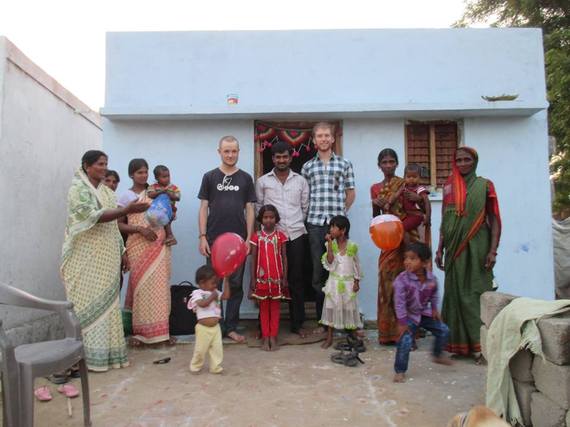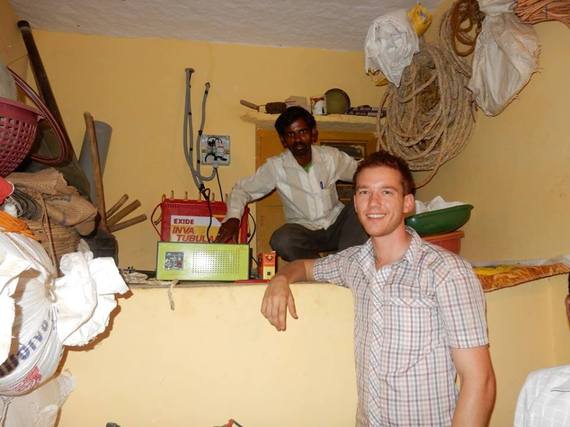On May 25, 2015, solar microgrid lighting illuminated the small farming village of Bommekallu, Karnataka, for the first time. Two grids, self-contained, connected two large solar panels to 22 houses, providing lighting insurance against the two to four hours of daily power cuts.
I was the main architect of these microgrids. The following article intends to describe my dream for these systems, the process of design, and the difficulties, practical and ethical, that I faced. Please note before I begin: I was a foreigner to the region, and my view is incomplete. Rural Karnataka's is a very different social and professional culture than ours. None of the ways that I present the villagers, my NGO, or myself are intentionally critical.
In 2014, the NGO had successfully built single-home solar lighting systems through the sanga, an NGO sanctioned worker's collective. In two pilot villages, sanga houses were each given a small, single solar panel on the roof with hall lights and a small house battery separate from other houses. The villagers had reported great satisfaction with their systems. However, the NGO had concerns about price: each system cost over $200 per house. Where would the money come from to build on a large scale, if not outside charity?
I thought of an electrical design and financial plan that I believed could: (a) save money, (b) create a sense of community, and (c) spread the systems by farmer contribution and not outside charity.
For (a), I noticed that bigger solar panels cost much less per unit of energy than smaller ones, and bigger batteries store energy more cheaply. If we could design a way to combine many of the smaller systems' solar panels and batteries into one larger system, we could save money.
For (b), I hypothesized that connecting a bunch of houses together would socially highlight the finitude of energy resources. Each hour that one house kept a light on was an hour that another house could not. Practice in this thinking could engender a sort of community around energy, getting villagers to think about energy as a collective resource.
Finally, for (c), I hoped too that, with the NGO's guidance, the sanga could administer, essentially, a zero-interest pay-it-forward loan. Through monthly user payments, the sanga could eventually save enough to commission a new system in a new village. In this manner, the initial investment would be a seed. The program would spread exponentially on its own, led by financially empowered sangas and not by foreigners.
Now, building a microgrid isn't necessarily new. However, most microgrid companies microgrids slap an electricity meter on each house and bill individually for usage. I dreamed instead of implementing subtle behavioral mechanisms that could allow us to eliminate the meters. Then, the task of conserving electricity among the users would truly become a daily exercise in community, relying on and strengthening the sanga.
****
I arrived in Bommekallu in early February, a three-hour, dusty bus ride away from Bangalore through deserts of spiky succulents. The first day was a shock. Bommekallu was qualitatively different than anything I had seen: 800 people in 80 or so houses clustered maybe a half mile in diameter and huddled under a rocky hill, gaudy colors over concrete, ranging from a single-roomed hut to a multistory behemoth. Bommekallu boasted one main concrete "road" with a single general store, more animals than people, and hectares of farmland in every direction. There might have been a single car; some villagers had motorcycles, but despite the obvious poverty, there was a sense of fierce self determination.
Bommekallu had two sangas established by the NGO: one for the lower caste families and one for higher caste. To start, I surveyed social and financial feasibility across the sangas.
The NGO and I held a meeting with the lower caste sanga to explain my concept and ask for volunteers. The meeting was at night in the village's one-room schoolhouse: dusty and aged concrete gave it a bombed-out, dilapidated feel. As typical, there was a blackout, so the entire audience was illuminated by two kerosene lamps the NGO had brought; this lent an eerie and secretive air to the meeting. Three NGO workers and I sat cross-legged in a line in front, and 70 or so villagers crouched or sat in giant blocks segregated by gender.
The general discussion was strange. Men asked the few clarifying questions, and whenever there was an uncertainty in my decision process, like how much money villagers would give upfront, a couple of men would voice their opinion as if it were decided. The NGO workers gave long speeches to describe small things. When the general concept of a microgrid was presented, people generally seemed to reject it out of hand.
"Come, we have so little, give us each a system for our home," a farmer shouted. "Give us something to call our own."
Voices rose, and a fight nearly broke out. Some men threatened to cut the wires of any microgrid that crossed their land, and others started shouting slurs based on political party. The most senior NGO worker turned to me, and then turned back to shout in Kannada, his voice laden with paternal derision:
"You people! You are so ungrateful! An American comes here on his government's money, and wants to build a microgrid. He is a scientist and a good man. You show disrespect? You reject his idea? Fine! We will go to another village. We have a thousand more we could go to. Not an issue! Come, come, let's go, Lucas."
The opposition quieted, mostly. A woman in a green sari who had been sitting silently near the front addressed us directly in an uncharacteristically even tone:
"Do not go to another village. I am Sushilemma, I represent the higher caste sanga, and I think I can get support among my members. I will get 10 signatures by Friday."
I was confused and uncomfortable. What had just happened? I didn't want people to sign on to this because of me or my country. I wanted to gauge the honest interest for this system, yet it seemed like people didn't fully understood the benefits of the microgrid. I wasn't fully comfortable with the NGO's response or with dropping the lower-caste sanga, but I wanted to show that my concept could work.
True to her word, days later Sushilemma delivered us a list of early signups, with a 1000 rupee down payment per family.
Sushilemma was important to me. Throughout the rest of the project, I would start my work in Bommekallu daily with tea and biscuits at Sushilemma's large, bright white and yellow concrete house near the center of the village, and often slept next to her son Anil on her concrete patio. I became close to Anil, who was about my age, cooked chapati with her older daughter, and learned to artificially inseminate cows from her husband. My "village mom", Sushilemma was my point of entry into the village's social life, something I think both of us took pride in.
During the next month, I busied myself in the dizzying array of construction details. Minimizing price constantly hung over my head. I designed a spatial statistics model to optimize the amount of wire needed for complete connection, contacted 5 solar panel companies and negotiated as ruthlessly as I could for the lowest price, and questioned every financial decision for a better, more optimal one.
The NGO fought me bitterly on some design issues, and I could not understand why. For example, I calculated that we could save a good deal on wires if we used wire of a smaller diameter, and still easily carry the maximum amount of energy. However, the NGO was concerned about monkeys climbing on the wires and chewing through them. So, I came up with an alternative: smaller wires coupled with cheap steel support. The NGO's leaders rejected it, crying,
"Do you want to give these villagers grapefruits? Or peanuts?"
For the life of me, I didn't get it. My proposal provided the same support and capacity at a lower price. Eventually I felt petty bringing up the small detail, even though it would save a significant amount.
I compromised where I could, and started construction. I cut deals with various companies and assembled the necessary electrical components. We hired three local electricians, and under the hot sun, started the wiring process. At first, no one wanted to let me work, and I stood by with the NGO field workers. I was bored out of my mind watching, so I pushed some basic assistance on them. Eventually, they let me work as another electrician, leaving the NGO workers to comment amongst themselves.
Two weeks later, the first system was done. It had cost around $100 per house. The leaders of the NGO and all the workers arrived, piling out of vans from another district over. The lights were ceremoniously turned on in front of a crowd, a round of applause rang out, and one of the village wives gave out jackfruit. The victory felt hollow and oddly political. I brought up my dream of sanga based spread. It was rejected.
The second system went up much more quickly. Days after the first system went on, we had twelve volunteers for a second system. I immediately hired six electricians, and we strung up the wires. A week later, we turned on the lights to the second system, to much less fanfare. I tried to bring up my financial plan again. It was rejected again.
The NGO had decided it was best to put all the monthly contributions aside for maintenance, and to funnel any excess into other programs of the villagers choice. All future solar systems would instead be built via charitable contributions from foreigners and big companies.
Affronted, I found this charity model frighteningly unreliable and less powerful than my sanga-powered model. But, as a newcomer and foreigner, I decided that I did not know enough to fight their decision. I had approached the problem with an intuition of American financial sustainability that would not necessarily work on Indian soil.
The monsoons rolled in a week later, and in early June I left the country for visa purposes, backpacking for a month through Vietnam, Cambodia, and Thailand. Mid July, I boarded a plane in Bangkok that was bound for Bangalore.
I returned to a system in chaos. Neither panel had time to fully charge the battery thanks to the monsoons, and for a variety of reasons the second system did not last as long as the first. The villagers were acutely aware of this. Some families blamed other families for misuse, others blamed the NGO, and a few threatened to stop paying their monthly payments.
Using a warranty, I replaced the battery, imposed a stricter cleaning schedule for the panel, and held a meeting reminding everyone of the community aspect. Every hour one family left one light on was an hour another family couldn't leave a light on. Through interviews, I saw evidence to suggest that a shift in mindset was beginning.
My grant period ended, and I left with mixed feelings. I believed in the quality of my design, but I felt the NGO didn't. They let me use their money to commission three more microgrids in another town, with certain structural improvements, but decided to use their single home system in the case of future charitable donations.
Who was right? The NGO had decades of local experience and had administered truly transformative programs. There were things I would never understand about their knowledge. Superficially, my system could double the number of families to receive backup lighting with the same amount of money. Shouldn't we focus on bringing more people to a threshold of living standards rather than bringing fewer people comfortably beyond? Was charitable investment a way to pay off past debt of imperialist inequality? Or should we solely empower communities to invest in themselves? Shouldn't we dream bigger, hope for more collective solutions, and take leaps? Trust communities to adapt?
Or was this all an outsider's pipe dream, a heavy-handed attempt to turn theory into practice?
I didn't know.


